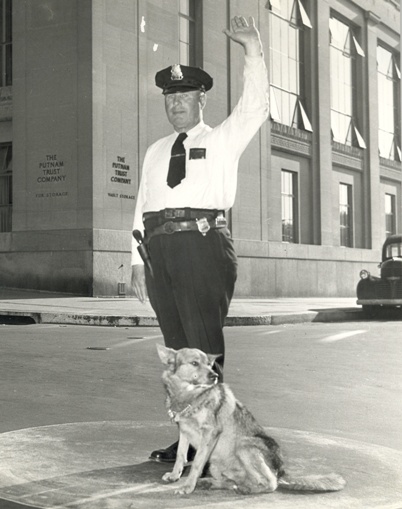By Karen Frederick and Anne Young
During the 18th and 19th centuries, Greenwich citizens relied on the services of state marshals and constables as well as county sheriffs. These law keepers were primarily charged with serving warrants, keeping the streets clear of obstructions, and enforcing all ordinances. Still, some townspeople wanted local peacekeepers, as reflected in this excerpt of an editorial written by a concerned citizen and published in The Greenwich Graphic on July 26, 1875:
Another important want is a reliable night-watch, and with that, a lock-up and lighted streets… They are all needed as a protection not only against fire, but also against house-breaking, rowdyism and robbery…. Greenwich has its full share of vile characters…great currents of tramps and gypsies runs freely through it… Then too, our proximity to New York makes us easily accessible to its professional rogues…Our Borough authorities hold a responsible position. To them it belongs to take the lead in providing for our security. To us it belongs to co-operate with and sustain them.
Again, on December 20, 1877, The Greenwich Graphic revealed the anxieties of some about the safety of their communities:
As reported in the newspaper…In these days of wholesale sin, when desperate villains can crush in human skulls with so much indifference as they can burn doors, and wash their hands in the blood of a human heart as in the waters of a brook, it is almost impossible for us to feel in my time that our lives and our property are not in imminent peril.
And, in fact, it was in the latter part of the 19th century that the first paid position of a night “patrol man” was created to check stores along Greenwich Avenue. Additional changes came at the dawn of the 20th century as the town’s law enforcement began to professionalize. As The New York Times reported on August 18, 1905:
[Greenwich which] was content for years with ununiformed policemen…from this day on will have a force of the gayest-looking cops in all New England…the [police] appeared on the streets looking more like Rear Admirals than regular everyday policemen.

Policeman on Greenwich Avenue, ca. 1950 – Greenwich Historical Society
New uniforms, however, did not signal universal approval from the townspeople, some of whom viewed the existence of a growing police force with skepticism. On July 25, 1907, The Greenwich Graphic reported that a Mr. Hubbard “stated the police department was an unnecessary and uncalled for expense and ought to be eliminated from the budget…[he] believed the Borough was just as safe two or three years ago with John Fulton as night watchman on the avenue and a watchman at the station.”
The Greenwich Police Department
As the needs of the community grew, so did the responsibilities of police and, necessarily, the number of officers. In 1950, 69 active officers served a town of 40,835 people. In 2000 there were 158 active officers serving 61,101 people. Today, their jurisdiction covers 47.8 square miles of land, 32 miles of coastline, and a population of over 62,000 people. In addition, four main arteries pass through Greenwich—I-95, the Merritt Parkway, U.S. 1, and Metro-North Railroad. Along these roads and waters pass ordinary citizens, hazardous materials, and illegal goods. Only the portion of U.S. 1 and the 32 miles of coastline falling within the Greenwich town lines are under the control of the Greenwich Police Department, yet they are usually the first responders for calls on I-95 and the Merritt Parkway.
While the Greenwich Police Department continues to enforce law and order, there is an increasing amount of focus on community needs, disaster response coordination, and terrorism prevention. Many of today’s recruits have a four-year college degree as well as additional graduate education. The police of the Town of Greenwich work closely with the other emergency responder departments as well as organizations whose missions reflect various aspects of public safety.
Karen Frederick, Curator and Exhibitions Coordinator, and Anne Young, former Curator of Library and Archives, of the Greenwich Historical Society contributed this article and co-curated the exhibition Everyday Heroes: Greenwich First Responders (September 14 through August 26, 2012) from which it is derived.









